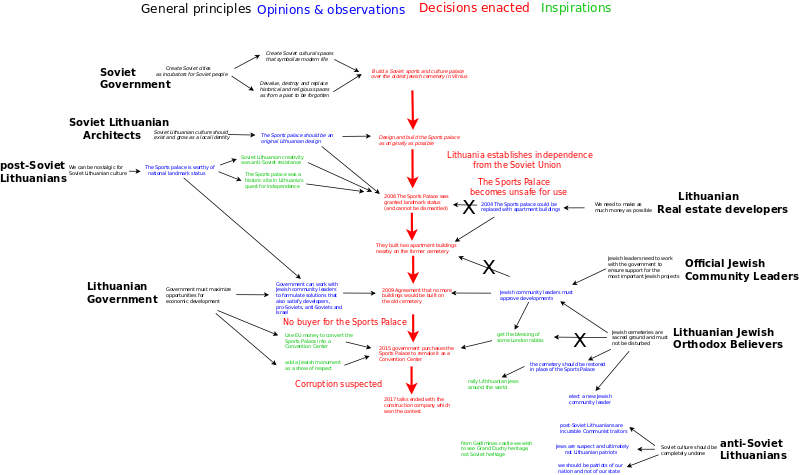Darbai
- Surinkti atsakymų į apklausą.
- Pasikalbėti su žmonėmis, ko reikėtų, kad jų nuostatos keistųsi.
- Nubrėžti įvairiausių nuostatų brėžinį.
- Nuostatas nagrinėti panašiai kaip nagrinėjau savo Minčių sodo atžvilgiu.
- Rinkti daugiau pavyzdžių iš asmeninio gyvenimo kaip ir kodėl keitėsi mano tapatybė.
- Išryškinti 12 sąvokų, kaip keitėsi tapatybė.
- Išsiaiškinti tapatybė kaitos lygčių gramatiką.
Plačiau paplatinti:
- Lietuvos žydų bendruomenei
- Tautininkam
- Peticiją pasirašusioms organizacijoms
- Edvardui
- Valstiečių ir žaliųjų partijai
- Vilniaus miesto merui
- Lietuvos kultūros ministerijos viceministrui
- Statybininkams
- Lietuvos architektams
- Nagrinėti kitus tapatybės kaitos pavyzdžius iš savo gyvenimo.
- Kaip suprasti Dievą, mus, šeimą?
- Palyginti su išgyvenimais, brandos rūšimis, rūpesčiais
Sporto rūmai
- Kultūros vertybių registras: Sporto rūmai nuotraukos, dokumentai
- Dėl Vilniaus koncertų ir sporto rūmų pritaikymo kongresų centrui projekto pripažinimo valstybei svarbiu kultūriniu projektu 2008 m.
Minkevičius, 2011: "Pastatas vertingas, visų pirma, tuo, kad jis pirmas Sovietų Sąjungoje sukurtas specialiai sportui ir žiūrovams. Architektūriškai ne tiek originalus, kiek originalios buvo jo vantinės konstrukcijos, kurių nebuvo niekur. Tai turi savo vidinę prasmę, nes tai buvo mūsų pasipriešinimo architektūrinė išraiška. Rūmai buvo kuriami kaip objektas, kuris nušluostytų nosį Maskvai. Ir iš tiesų - gauta SSRS Ministrų Tarybos premija. Kartu buvo įtvirtinta, kad mūsų architektūrinė kultūra aukščiau nei jų. Štai kur esmė ir to paminklo vertė."
Tapatybė
- Kaip keičiasi mūsų tapatybė? Kaip keičiasi su kuo tapatinamės? Kaip keičiasi riba tarp savų ir svetimų? Kaip galima paskatinti tos ribos pasikeitimą?
- Aš - glūdintis 12 tapatybės lygtyse - yra vienybės pagrindas, tad Dievo ženklas
- Tapatybė susijusi su savastimi, su jos riba, užtat su atskyrimu, kas lengvai keičiasi ir kas niekaip nesikeičia. "Įsikibk" - tai ryšium su savastimi. "Kaupk" - tai savasties augimas. "Rinkis gerą vietoj blogo" - tai už savasties. Patys poreikiai yra tarsi pramanyti, kas apibrėžta yra būdai, kuriais poreikius tenkiname.
Mano tapatybės kaitos pavyzdžiai
- Supratimas, kai buvau mažas vaikas, kad aš be galo protingas.
- Supratimas, kad aš esu geras vaikas.
- Supratimas, kad savo tautybę galiu rinktis, tačiau paprasčiausia būtų rinktis būti lietuviu, o jeigu sąmoningai to siekti, reikėtų valingai mąstyti lietuvių kalba
- Kreipiausi į Dievą, prašiau leisti man viską mąstyti, kad galėčiau viską žinoti.
- "K-I-L-L, Kill - Magnolia"
- Supratimas, kad nesu savo protas, esu savo valia.
- Supratimas, kad mano tėvai manęs nesupras - nepalaikys mano filosofijos.
- Supratimas, kad esu savo sesutei ir broliui tolimas.
- Lacie Diaz pasakė, kad man nedera keiktis, man tai netinka
Nuostatų rūšys
- Versti - dėsniai
- Liepti - sprendimai
- Aiškinti - nuomonės
- Klausti - įkvėpimai
Dovid, Julius, Evaldas, Ryte, Shnayer,
I'm working on my presentation for this Friday, "Moral Imagination: What Do We Wish to See? Soviet Sports Palace vs. European Convention Centre vs. Historic Jewish Cemetery" http://www.ms.lt/sodas/Book/MoralImagination
I attach a diagram which I drew of how the argument is unfolding (which is what I'm studying as a philosopher). Perhaps you'll have thoughts on how to improve it, or ideas of how to use the diagram.
I include the perspectives of 8 groups. I color coded:
- General principles. (Black) These can't change because they are part of self-identity. Anti-Soviets are necessarily "anti soviet", for example.
- Opinions and observations. (Blue) These can change but its not easy.
- Decisions enacted. (Red) These are actions taken which are hard to undo. This is the common history that the different groups have to deal with. I also noted some events that are gamechangers, typically because they sideline one of the groups (like the fall of the Soviet Union).
- Inspirations. (Green) These are ideas, strategies or outlooks that expand the possible solutions.
In this simple model, I have distinguished two broad groups of Lithuanians:
- anti-Soviets (former "dissidents"), who speak of Soviet-occupied Lithuania, and for whom "Soviet culture should be completely undone".
- post-Soviets (former "collaborators"), who speak of "Tarybų Lietuva", and for whom "We can be nostalgic for Soviet Lithuanian culture".
I attribute to the latter two inspirations which helped the Sports Palace get on the Cultural Heritage Registrar:
- "Soviet Lithuanian creativity was anti-Soviet resistance"
- "The Sports Palace was a historic site in Lithuania's quest for independence"
This seems to have kept the Sports Palace from being demolished and replaced with apartment buildings.
There's an important interview with architect Jonas Minkevičius (born 1929) from 2011: http://www.respublika.lt/lt/naujienos/lietuva/kitos_lietuvos_zinios/tauta_ugdo_ne_alus_ir_krepsinis/,print.1 Interestingly, he was an anti-Soviet, and in 1971 as such was dismissed from teaching at the Vilnius Art Institute in Kaunas. But he nicely expresses what I call the "post-Soviet" point of view:
"The building is valuable, first of all, as the first in the Soviet Union built especially for sport and for spectators. Architecturally it is not so original, as is its cable-stayed structure, which was nowhere else. That has its own inner meaning, because that was our resistance through architectural expression. The palace was created as an object that would show up Moscow ("wipe its nose"). And truly - it won a USSR Council of Ministers award. And thereby it established, that our architectural culture is higher than theirs. This is the point and the value of this monument."
And he made a similar argument regarding the Soviet Lithuanian statues on the Green Bridge (which were recently removed, nevertheless): http://www.ve.lt/naujienos/visuomene/sociumas/architektas-jonas-minkevicius-issigandome-patys-saves-1386947/ His point is that these statues are a "degradation" as regards artistic merit (the level was higher before the war) but they can be respected as "a compromise with one's conscience", "a struggle to survive or to perish", "to be or not to be". "It is a monument to history. The condition we were subject to. And also a monument to our invincibility, our inner hardiness."
My diagram suggests that for the Lithuanian government to change its position there needs to be support for the Jewish cemetery from both the anti-Soviet and post-Soviet perspectives. From the anti-Soviet side we can speak with the argument "What do wish to see from Gediminas castle, the Grand Duchy heritage (the Jewish cemetery), or the Soviet heritage (the Sports Palace)." The paradox is that the anti-Soviets also tend to be not-Jewish-minded and so instinctively prefer the Sports Palace until made conscious of the absurdity. Which is to say, it is a good argument to make.
However, there needs to be a separate argument for the post-Soviets. Here I suggest to build on Jonas Minkevičius line of thinking. Basically, Soviet Lithuanian culture is to be treasured not because it was objectively great (generally, it wasn't) but because it was indeed an "inner resistance" by distinguishing us from generic Soviet culture and the dominance of Moscow and its imperatives. So then Soviet Lithuanian culture should be honored with a respectful Museum of Soviet Lithuanian Culture where it could be presented in the proper context. And then we can say that the objectively "degenerate" artefacts can be removed from our public life. As a plus, the museum could incorporate the concrete and the furnishings that we'll have when we dismantle the Sports Palace.
I suppose that's the message of my talk. I'm curious what you think, or what else you think is perhaps more important, as regards winning over all sides.
Andrius
Andrius Kulikauskas VGTU Lecturer ms@ms.lt +370 607 27 665
DorovinėVaizduotė
Naujausi pakeitimai
网站
Įvadas #E9F5FC
Klausimai #FFFFC0
Teiginiai #FFFFFF
Kitų mintys #EFCFE1
Dievas man #FFECC0
Iš ankščiau #CCFFCC
Mieli skaitytojai, visa mano kūryba ir kartu visi šie puslapiai yra visuomenės turtas, kuriuo visi kviečiami laisvai naudotis, dalintis, visaip perkurti. - Andrius

